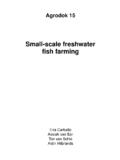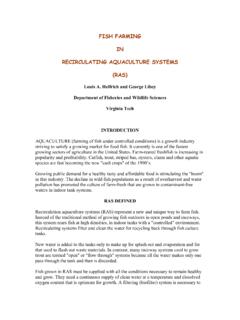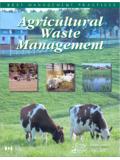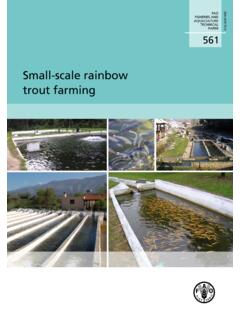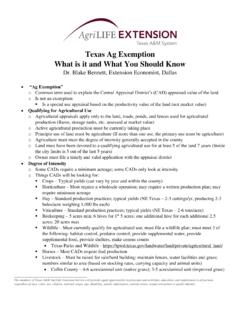Transcription of Mangrove Restoration - Costs and Benefits of Successful ...
1 11 In review, Proceedings of the Mangrove Valuation Workshop, Universiti Sains Malaysia, Penang, 4-8 April, 2001. Beijer International Institute of Ecological Economics, Stockholm, Sweden. Mangrove Restoration - Costs and Benefits of Successful Ecological Restoration Roy R. Lewis III ABSTRACT Mangrove Restoration - Costs and measures of Successful ecological Restoration . Roy R. Robin Lewis III, President, Lewis Environmental Services, Inc. Box 5430, Salt Springs, Florida, USA, 32134-5430. The Costs to successfully restore both the vegetative cover and ecological functions of a Mangrove forest have been reported to range from USD$225/ha to USD$216,000/ha. Unpublished data would indicate that the even higher Costs , as much as USD$500,000/ha, has been spent on individual projects. These are obviously cost prohibitive amounts for most countries seeking to restore damaged mangroves. I divide the types of Mangrove Restoration projects into three categories: (1) planting alone, (2) hydrologic Restoration , with and without planting, and (3) excavation or fill, with and without planting.
2 The first type, planting only, although inexpensive ( : USD$100-200/ha) usually does not succeed due to a failure to appreciate the physiological tolerances of mangroves to tidal inundation. Even if it works, the result is often replacement of one productive marine habitat, like seagrass meadows with mangroves, a questionable trade-off. The second type, hydrologic Restoration , can be done for similar Costs , and with proper planning has a high success rate. Successful Restoration of abandoned shrimp aquaculture ponds is an example of this method. Planting should only be done if natural recolonization fails, and can double the cost of a project. Scientific data indicates that using this method, ecological functions are quickly restored, with fish populations typically reaching reference site diversity and densities within 5 years. The third type, excavation and fill, is the most 22 expensive due to the high Costs of large scale earthmoving. It is only a viable option in more developed countries, and may not be a cost-effective means of Restoration except under limited circumstances.
3 1. Introduction Restoration of existing areas of damaged, routinely harvested or destroyed Mangrove forests have been recently estimated to cost between USD$3,000/ha and USD$510,000/ha (Spurgeon 1998). Unfortunately these estimates are primarily derived from a single secondary source and are referred to as .. Costs for planting (page 374 in Spurgeon 1998)(emphasis added). As noted by Turner and Lewis (1997) and Lewis (1999), hydrologic Restoration without planting is often preferred as planting of mangroves often fails due to what Lewis and Marshall (1998) refer to as the gardening approach to Mangrove Restoration . This approach emphasizes planting of mangroves without first investigating the reason why mangroves are not present in the first place. This can be the most expensive approach to Restoration since any investment is wasted when planted seeds or seedlings fail to survive.
4 Natural recolonization of areas with restored hydrology, such as reconnected abandoned shrimp aquaculture ponds , occurs quite rapidly if Mangrove forests are present in the vicinity and natural production of propagules is sufficient (Stevenson et al. 1999). In consulting the original literature on Mangrove Restoration (Watson 1928, Noakes 1951, Chapman 1976, Lewis 1982, Hamilton and Snedaker 1984, Lewis 1990a, Lewis 1990b, Crewz and Lewis 1991, Cintron-Molero 1992, Saenger and Siddiqi 1993, Siddiqi et al. 1993, Field 1996, Lewis 1999 and Lewis and Streever 2000) one finds few discussions of the Costs of Restoration . Because of this historical lack of data on cost effective Restoration , and lessons learned , many myths about Mangrove Restoration persist. The tiny two page paper entitled Mangrove mythology (Snedaker 1987) is one of the few classics in myth busting. In it, Jane Snedaker proposes a true or false test with five questions.
5 These are: 33 1. Mangroves require salt water to develop and grow. 2. Mangroves extend shorelines. 3. Mangroves build up land. 4. The red Mangrove [Rhizophora spp.] is the most valuable species. 5. Some Mangrove forest types are more important than others. How would you answer? In fact, all are common myths, and all are false! Much of what is known about mangroves and in particular Mangrove Restoration , is based upon such myths. It is not surprising then that attempts to restore mangroves often fail to achieve the stated goals or fail completely. Similar myths about the value, both intrinsic and of direct impact to economic activities of man still persist. As recently as March 30, 2000, the Jakarta Post reported that 80,000 ha of wasteland (actually mangroves) had been converted to the ..worlds largest integrated shrimp at Lampang, Sumatra (front page). We will attempt to shed some light on additional myths mangroves and discuss the real Costs and Benefits of Mangrove Restoration , and how to minimize the first while maximizing the second.
6 As noted by Spurgeon (1998) If coastal habitat rehabilitation/creation is to be widely implemented, greater attempts should be made to find ways of reducing the overall Costs of such initiatives; devise means of increasing the rate at which Benefits accrue; and to identify mechanisms for appropriating the environmental Benefits (p. 382). 2. Why restore? Mangrove forests are coastal plant communities that are part of a larger coastal ecosystem that typically includes mud flats, seagrass meadows, tidal marshes, salt barrens and even coastal upland forests and freshwater wetlands ( peatlands), freshwater streams and rivers. In more tropical climates coral reefs may also be part of this ecosystem. They are critical 44 habitat for many species of fish and wildlife, serve as coastal fish and shellfish nursery habitat, and produce large quantities of leaf material that becomes the basis for a detritus food web (Hamilton and Snedaker 1984, Lewis et al. 1985).
7 Once established, they can serve as coastal protection from hurricanes and typhoons, and riverine mangroves help remove pollutants before they enter adjacent coastal waters. In spite of these documented ecological functions, Mangrove forests have been dredged and filled for decades to provide other coastal uses, like ports and housing. It is estimated that there are 181,399 sq km of Mangrove forests in the world (Spalding 1997) and major historical losses have occurred. In the Philippines the losses are estimated at 60%, Thailand 55%, Viet Nam 37% and Malaysia 12%. The total area lost in just these four countries is estimated at 7,445 sq km. Anecdotal estimates are that up to 50% of all mangroves that historically existed may have been lost to date and that current rates of loss may be as high as 1% per year. In the United States, where much of the pioneering work on wetland Restoration technology has been done (see Lewis and Streever, 2000) mangroves naturally occur in three states, Florida, Louisiana and Texas.
8 They have been introduced in Hawaii, but probably never naturally occurred there. They are also present in the U. S. Virgin Islands, Puerto Rico and several Pacific Ocean territories. The largest forests are in Florida, where approximately 200,000 ha remain from an estimated historical cover of 260,000 ha (Lewis et al. 1985). These forests contain three species, the red Mangrove (Rhizophora mangle), the black Mangrove (Avicennia germinans) and the white Mangrove (Laguncularia racemosa). The buttonwood (Conocarpus erectus) is a transition zone species. In Texas, only 2,000 ha exist (Moulton et al. 1997). Louisiana mangroves are very limited, with only several hundred hectares of the cold tolerant black Mangrove located around Grand Isle. Puerto Rico has just 6,410 ha of Mangrove remaining from an original Mangrove forest cover estimated to have been 24,310 ha (Martinez et al. 1979). These figures emphasize the magnitude of the loss, and the magnitude of the opportunities that exist to restore areas like mosquito control impoundments in Florida back to functional Mangrove ecosystems (Brockmeyer et al.)
9 1997). These opportunities, and a growing interest in wetland Restoration , combined with 55 strong legal requirements to replace any wetlands lost to permitted development activities have created a heightened interest in cost effective Mangrove Restoration . 3. Key terms and principles Restoration or rehabilitation may be recommended when a system has been altered to such an extent that it can no longer self-correct or self-renew. Under such conditions, ecosystem homeostasis has been permanently stopped and the normal processes of secondary succession (Clements 1928) or natural recovery from damage are inhibited in some way. This concept has not been analyzed or discussed with any great detail in Mangrove forests (Detweiler et al. 1976, Ball 1980, Lewis 1982 are the few exceptions) and thus Restoration management has, unfortunately, emphasized planting of mangroves as the primary tool in Restoration , rather than first assessing the reasons for the loss of mangroves in an area and working with the natural recovery processes that all ecosystems have.
10 Even the use of different terms and confusion in their meaning also adds to the difficulty in determining which of these projects actually succeeded in restoring a previously existing Mangrove forest (ecological Restoration ) or converting a natural mudflat into mangroves (habitat substitution as described in Erftemeijer and Lewis 2000). For example the terms replanting and reafforestation are commonly used. Replanting would seem to mean planting a second time after an initial planting . Similarly, reafforestation would seem to mean planting a second time after a first effort at afforestation . Afforestation is a widely used term in forestry and refers to planting of trees in areas that have not previously been forested. What would be a better approach? How often are the existing stresses determined before trying to just plant? The answer to this latter question is all too rarely. The term Restoration has been adopted here to specifically mean any process that aims to return a system to a preexisting condition (whether or not this was pristine) (sensu Lewis 1990c and Lewis, this volume), and includes natural Restoration or recovery following basic principles of secondary succession.











